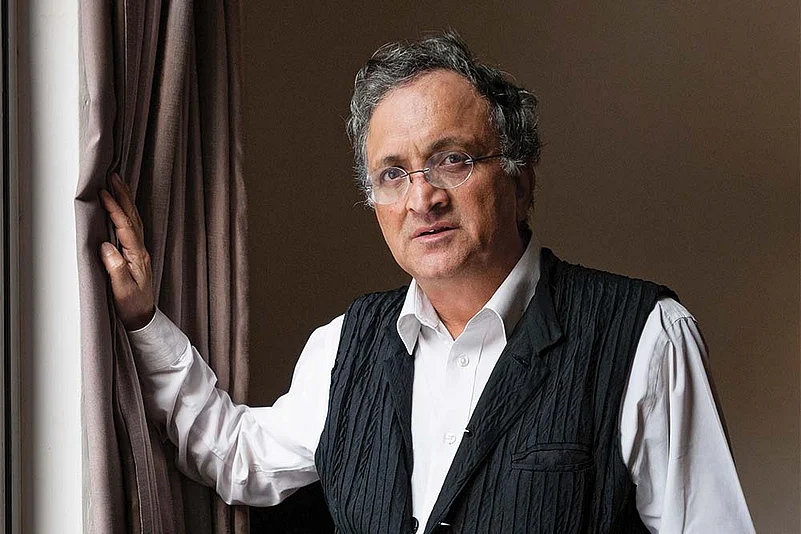Chipko
The year was 1981. I was at Forest Research Institute in Dehradun at the invitation of my entomologist friend, Dr Sen Sharma to give a talk on elephant social behavior. At the end of the talk, he introduced me to the then 23-year-old Ram, saying that his father was a chemist, a colleague of his at FRI and that Ram was interested in talking to me. I found Ram full of enthusiasm, and greatly enjoyed chatting with him over the next hour and half. Ram had been brought up in Dehra Dun and had studied in the Dun School, following which he had obtained a Bachelor’s degree from St Stephen’s College and a Master’s from Delhi School of Economics. These were all highly prestigious educational institutions where many a rich and famous Indian including Rajiv Gandhi, Karan Singh, Jyotiraditya Scindia and Mani Shankar Aiyar had studied. Indeed, Mani Shankar Aiyar is notorious for his contemptuous remarks about people who have not had the advantage of such a sophisticated education. But Ram had no such false airs. He explained that he was a nature lover, fond of the Himalaya. He was fascinated by birds from a young age and at the age of twelve had written an article on the birds of the Dehra Dun’s New Forest in the ‘Newsletter for Birdwatchers’. He now wished to switch to sociology from economics and had just begun his Doctoral research on the Chipko Movement at the Indian Institute of Management in Kolkata.
Beginning with the British regime, the natural resources of the Himalaya had been plundered at a fast pace. This pace had only increased after independence. The cost of this exploitation was being imposed on the local people, who were suffering in many different ways, with huge landslides, and floods that washed away entire villages. An important cause of this damage was felling of trees. Trees were being supplied to industrial enterprises at throw away prices. One such enterprise was the manufacture of badminton rackets.
The Chipko movement had begun in 1973 as a result of peoples’ struggle to halt this felling of tree against their wishes. It had attracted a great deal of public attention with extensive news coverage. This movement had a long history. People had been registering their protests in many different ways over decades. A great deal of documentation was available on such protests. In recent decades, students of history had given up focusing exclusively on those in power and had begun to record history centered on the common people. Studies were appearing on how people at the bottom of the society struggle to fulfill their aspirations. Ram was interested in working on the Chipko Movement employing this new paradigm.
I was a biologist primarily interested in ecological issues. Since 1971 I was engaged in field studies in hilly regions, in forested tracts. I was exploring how the paper mills were mercilessly exploiting the forest resources, how centuries-old sacred groves were being cut down to feed the plywood mills. I, too, was fascinated by the Chipko Movement. Indeed, I was planning to proceed from Dehradun to Bemru village in Garhwal to participate in a 10-day eco-development of Dasholi Gram Swaraj Sangh, a leading organization involved in the Chipko Movement. I discussed his research methodology with Ram. Like all other students of history, he was going to focus on historical documents. I suggested that the written documents often give an incomplete, perhaps distorted, view of reality. So, by all means, Ram should study the documents, but Chipko was a living, ongoing movement, and Ram must complement his archival research with field work with people on the ground. Ram is a very friendly soul and he easily gets along with all sorts of people. He readily accepted my suggestion and launched on his path-breaking work on Chipko.
Kolkata
It was clear from that first chat in Dehradun that Ram was a young man of remarkable intelligence, brimming with curiosity. His love of nature, his concerns about people, his egalitarian beliefs, his faith in the democratic processes, all of this was in tune with my own inclinations. So, when the professor he was working with at the Indian Institute of Management asked me to serve on his Thesis committee, I readily agreed. At that time my good friend Kailash Malhotra, a brilliant student of the anthropologist Irawati Karve, was a Professor in the Anthropometry and Human Genetics Unit of the Indian Statistical Institute in Kolkata. We were collaborating on a number of studies in the field of human ecology. From time to time I used to visit Kolkata to work with Kailash and continued my interactions with Ram.
Ram was a person with a very broad range of interests, spanning natural history, literature, music, sports, society, polity, economy and history. He was also a talented cricket player and had played alongside Kirti Azad and Arun Lal on the St. Stephen’s College cricket team. With his wide-ranging interests and extensive reading, he was doing brilliantly in the then newly fashionable quiz contests. Ram was the runner-up in the then popular all India quiz of Siddharth Basu. One of his rivals was one of the founders of Infosys, Nandan Nilekani, at that time a student in IIT Bombay. Naturally they had struck a friendship. Ram knows well many such well-known personalities, but is as courteous to the common people as to the rich and the famous.
An accomplished Writer
Ram had then launched on his writing career. Beginning in 1982, he began contributing to the left leaning magazine, Frontier, always writing without fear and favour. He even criticized J. Krishnamurti, revered by many and declared to be an avatar of Krishna by Annie Besant. He had also started writing on cricket, a game he loved and understood well, bringing his sociological perspective to bear on the history of the game. I too was greatly interested in history and in sports, having once been Maharashtra state junior high jump record-holder. Naturally, I thoroughly enjoyed Ram’s writing.
Ram’s PhD thesis on the Chipko Movement, set in the framework of how disempowered people struggle in pursuit of their interests, combined careful examination of historical documents with live interactions with people in the field. I read the thesis with great care, thoroughly enjoying the experience. In 1980 the Forestry establishment had attempted to float a new forest policy that would have further consolidated powers of this biggest landlord of India, leading to a vigorous public debate. In a significant contribution to this debate, Ram published in 1983 a paper on Forestry in British and post-British India in the Economic and Political Weekly, demonstrating his mastery of writing that was at once scholarly yet readable.
Then he published ‘The Unquiet Woods’, a path breaking study of Indian environmental history based on his PhD thesis on Chipko movement. I had at that time been working for well over a decade on management of natural resources in India and exploring how these experiences fitted in the broader framework of history, sociology and ecology. I had been toying with the idea of summarizing all of this in the form of a book but had made little headway. Ram obviously had a deep understanding of the issues involved and much information that complemented what I had gathered as a part of my own studies. Even more importantly he was an accomplished writer. So, I proposed to Ram that we collaborate on a book on the ecological history of India. He liked the idea, and happily accepted a position as an Assistant Professor of Management Studies at the Indian Institute of Science in Bengaluru.
Ram had a long family association with the Indian Institute of Science. His father, a chemist, had obtained his master's and doctoral degrees at the IISc. K Venkataraman who was married to Ram’s aunt was a well-known chemist and had served for many years as the first Indian director of the National Chemical Laboratory. He was very fond of Ram and declared that Ram should be his last PhD student. But Ram did not find the school science laboratory to his liking. So, he told Ram that he should do a thesis with his daughter, Ram’s cousin Dharma Kumar, a leading economic historian of India. But economics too did not agree with Ram and he turned to Sociology.
Ram certainly wrote a first-rate PhD thesis in the scholarly tradition of the universities. But he was not cut out for the routine of an academic career. He had very wide interests and was a talented writer. His special skill lay in exploring newer fields and writing learned yet readable articles and books. Beginning with his thesis on the Chipko movement he has written a series of books that have become popular; but are packed with novel information and insights. As of today, he has written 12 and edited 11 books. His ‘India after Gandhi’ has established itself as the leading study of India’s post-independence history. Only two of his 12 books have been co-authored with somebody else and I have the privilege of being that co-author. These are “This Fissured Land” and “Ecology and Equity”. This Fissured Land, an ecological history of India, written over quarter of a century ago is still being regularly reprinted and is being used as a text-book in many Universities.
Ram served on the faculty of the Indian Institute of Science for 2 years and then moved over first to Delhi University and then to the Nehru Memorial Museum and Library. Following this stint, he has devoted himself to independent writing and visiting assignments in different universities for the last two decades. He lives in Bangalore with his wife Sujata, a designer who established the leading design firm, Ray and Kesavan.
Historian
Ram has written a most enjoyable and entertaining book on history of cricket, “A Corner of a Foreign Field”, sheding new light on the subject in his own inimitable fashion. When the sport was striking roots in India and accomplished Indian cricketers were beginning to emerge, the two most notable names were the batsman Ranjitsinhji, a prince of Nawanagar, and the bowler Balu Palwankar, born in a poor, dalit family. Balu Palwankar developed into an outstanding spinner while working as a labourer on the grounds of the European Gymkhana in Pune on a salary of 3 rupees a month. He was then employed by the English captain of the European Gymkhana team to give him batting practice, paying him eight annas every time Balu managed to get him out. As his reputation grew, Balu was invited to play for the Hindu Gymkhana team. While Hindu Gymkhana was winning matches thanks to Balu’s bowling skills, the other players would not allow him to eat his meals or drink his tea alongside them. Justice MG Ranade criticized them severely for such behaviour and Lokamanya Tilak felicitated him in teeth of protests of the traditional Pune society. So knowledgeable a cricketer as Vijay Merchant has remarked that Indian cricket gained respect due to Ranji’s batting and Balu’s bowling. While we continue to remember Ranji thorugh many events such as the Ranji trophy matches, Balu has been totally forgotten.
Ram is utterly free of any prejudices relating to caste, creed, colour or wealth. He has particular sympathy for the have-nots. Naturally, Ram has celebrated Balu’s accomplishments in his book. Ram, a truly committed scholar, put in a remarkable amount of effort to collect the relevant information, and to understand the society and the way it functioned in Balu’s time. He arranged to get all the news relating to Balu published in Lokamanya Tilak’s Marathi newspaper, Kesari translated in English. He then followed up on Balu’s family history and contacted some of his kin in the Thane-Dombivli areas of Greater Mumbai. Mama Varerkar, a contemporary of Balu’s and a progressive writer and thinker, has written a Marathi play inspired by Balu’s life titled “On the door step of the prison”. The name of the play reflects his conviction that the higher caste society has imprisoned itself to its own serious detriment through its prejudices. Ram managed to lay hands on a copy and turned up one day up in my house with a request to carefully read the play, explain it to him from beginning to end, and tell him what the play suggested about the society of that time.
Biographer
Verrier Elwin was a British anthropologist as aware as Ram is today of the inequities of the Indian society. He was married to a Gond lady, was greatly respected by Jawaharlal Nehru and played an important role in formulation of the state policies towards tribals in early years of Indian independence. Ram wrote a biography, titled “Savaging the Civilized” bringing out many new facets of Elwin’s life. This biography became so well known that close friends of two Bharat Ratnas, Atal Bihari Vajpayee and CNR Rao requested Ram to write their biographies. This would have been a golden opportunity to come close to these two famous and influential personalities. But Ram was not at all tempted and politely declined to oblige them.
So, going beyond Bharat Ratnas, Ram embarked on a biography of the father of the nation, Mahatma Gandhi. An enormous amount has already been written on Mahatma Gandhi, yet Ram came up with much new information and insights. He visited the school where Mahatma Gandhi had studied, and many places where he had stayed in South Africa. The first volume of this biography has appeared as “Gandhi before India” and when completed the two-volume work promises to become established as a major contribution to our understanding of India’s freedom movement.
Journalist
Apart from his books, Ram is a very popular newspaper columnist. His English articles regularly appear in leading newspapers such as the Hindu, Hindustan Times and Statesman. These are translated and regularly published in many Indian languages. In today's iniquitous society of India, the gulf between the educated, better off middle classes and the increasingly impoverished masses of India is rapidly widening. As a result, much of the material reaching the middle classes entirely fails to bring out the stark reality of the distortions in the course of development in India. Ram’s writing is a notable exception.
For a long time now, Goa has been afflicted by the tyranny of the rich. Three of my good friends have been victims of this state of affairs. Bismark Dias died under very suspicious circumstances, Hanumant Parab escaped by the skin of his teeth from a murderous attack and Ravindra Velip, was taken into custody on flimsy excuses and while lodged in the jail was attacked by hired goondas. When I informed Ram of these tragic occurrences, he came to Goa on his own and exposed this reality through an article in Hindustan Times. The article concludes with this statement “Although most Indian and foreign tourists may not know or care, something is very rotten in the state of Goa. The citizens of Goa know and care, since they see and experience it all the time.”
I am a very good friend of Ram’s, so I wanted somebody who had never personally met Ram to spend some time with him and tell me of his impressions. Luckily my good friend Subodh Kulkarni, a devoted social worker had the opportunity to spend two days in April 2016 accompanying Ram on his visits to families of Bismark Dias and to the village of Ravindra Velip. He has jotted down the following impressions at my request:
“Wherever we went, whether to Father Bismark’s house or Ravindra’s Caurem village, he was very alive to the situation and carefully absorbing all relevant information. He wasted no time in talking about irrelevant matters, did not use his mobile phone at all or indulge in photography or sit down to make long notes in a notebook. To me this was a most unusual behavior. While very alive to the present, he always places it in its historical context. He is totally committed to carefully listening and understanding while talking to people. He avoids making any remarks about any individual, institution or political grouping, but tries to understand the root causes of what has been going on and the driving forces behind these happenings.
He successfully brought out late Father Bismark's personality by gently getting all his relatives to talk about him. Bismarck’s house was, of course, engulfed in grief following his untimely death; nevertheless, we could come to understand Bismark's childhood and youth, his embracing the profession of a Christian priest, his love of music and of environment and all the struggles he was involved in as we talked to his mother, sister and brothers. Ram’s transparent honesty persuaded these people to talk to him freely from their hearts. He talked with a great deal of sympathy to Ravindra and his colleagues, and sincerely expressed his respect and admiration for their struggles. This has certainly given a great moral boost to the people of Caurem in their grave difficulties. What was most impressive throughout was his complete honesty, simplicity and genuine humanity. “
Moral courage
Ram has come to be widely admired and respected since a fairly young age entirely on the strength of his own achievements. Lakhs of readers read his newspaper columns. They learn a great deal from his completely unbiased, factually accurate and forthright exposition of what is happening all around us today. Ram is a well-known public speaker and attracts huge audiences wherever he may be speaking in India. His scholarly but highly readable books are in great demand. New York Times felicitates him as the best writer of non- fiction in India. Leading universities like Yale confer on him their honorary degrees. President of India decorates him with Padmabhushan.
I am fortunate enough to know many people of considerable achievements including Padma Vibhushans, Bharat Ratnas and Nobel laureates. But Ram stands out among them all. He is as simple and sincere today as he was when he met me as a twenty-three-year-old student. Ever since that time, he has been marching ahead, looking for no favours, and fearing nobody. That is why he continues to contribute to nation building through his meaningful and impactful writings.
This web-exclusive column does not appear in print magazine.

























